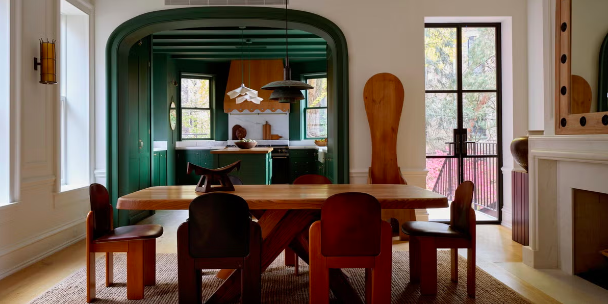Styling with Vintage: How to Blend Old + New Like a Pro
There’s something special about mixing vintage and modern pieces in a home—it creates depth, character, and a curated feel that makes a space feel lived-in yet stylish. But finding the right balance can be tricky. Go too far with the vintage, and it might feel like you’re living in a time capsule. Too much modern, and you might lose that warmth and charm vintage pieces bring.
So how do you blend the old with the new without it looking accidental? Let’s break it down.
1. Start with a Neutral Base
When mixing vintage and modern elements, a neutral foundation helps everything feel cohesive. White, beige, gray, or soft earth tones on walls and large furniture pieces allow vintage accents to shine without overwhelming the space. If you love color, keep large surfaces neutral and add bold vintage pieces in the form of artwork, textiles, or accessories.
SOURCE: Jonathan Pilego
2. Mix Materials for Contrast
Pairing different materials creates visual interest and keeps a space from feeling one-dimensional. Think:
• A sleek modern sofa with an ornate antique wood coffee table
• A contemporary marble dining table with vintage upholstered chairs
• A vintage brass mirror above a modern floating vanity
By intentionally mixing old and new materials, your space feels layered and intentional rather than mismatched.
SOURCE: Apartment Therapy
3. Let One Piece Be the Star
If you have a vintage showstopper—whether it’s an antique armoire, a weathered farmhouse table, or a mid-century lounge chair—let it shine. Balance the space by surrounding it with modern elements so it doesn’t compete with other vintage pieces. The same goes in reverse: a super modern centerpiece (like a sleek sectional) can be warmed up with vintage rugs, side tables, or lighting.
4. Use Vintage Lighting for Instant Character
Lighting is one of the easiest ways to introduce vintage elements into a modern space. A stunning antique chandelier in a minimalist dining room or a pair of vintage sconces in a modern hallway can completely transform the vibe. If you find a beautiful vintage lamp but aren’t a fan of the wiring, don’t hesitate to have it rewired—it’s worth it for the charm it brings.
5. Layer in Vintage Accessories
If you’re not ready to commit to big vintage pieces, start small. Accessories like:
• Vintage books stacked on a coffee table
• A retro clock or radio on a modern shelf
• Antique picture frames mixed with modern art
• A collection of vintage vases on a sleek console
These little touches add warmth and personality without overpowering the space.
6. Blend Time Periods for an Eclectic Look
Mixing different eras creates a collected-over-time feel. Instead of sticking to one vintage style (like all mid-century or all Victorian), experiment with blending. A rustic farmhouse bench can sit beautifully next to a modern dining table, and an Art Deco mirror can complement a contemporary dresser. The key is finding a common element, whether it’s color, material, or shape.
7. Make It Personal
The best interiors tell a story. Incorporating vintage pieces with meaning—like a dresser passed down from a grandparent, a flea market find from a memorable trip, or a framed vintage map of your hometown—makes your space uniquely yours.
8. Don’t Forget About Texture
One reason vintage pieces bring so much charm is their texture—chippy paint, worn leather, aged wood, and woven fabrics all add warmth and contrast to modern elements like glass, metal, and polished surfaces. Use this to your advantage by incorporating a mix of textures throughout your space.
Blending vintage and modern is all about balance. When done right, it creates a space that feels timeless, personal, and effortlessly stylish. Whether you go bold with a vintage statement piece or just sprinkle in a few antique accessories, the mix of old and new makes a home feel layered and lived-in—exactly how a home should feel.
Are you a fan of mixing vintage and modern? Let me know in the comments!








